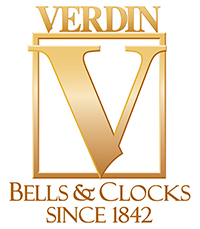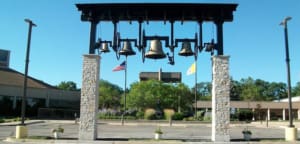Most of the bell foundries that have cast bells in the United States were located in the Northeast; Massachusetts, Vermont, Pennsylvania, New York, Maryland, and in the Midwest; Cincinnati, OH and St. Louis, MO.
Here are some notable milestones for early bell casting in America:
- In 1717, John Philips of New York City was the first founder to call attention to his craft.
- The next bell founder who cast any notable bells was John Whittier of Fairfield, CT. He started casting bells in 1738. He would cast bells up to 2,000 lbs. which was certainly a very large bell for the time.
- John Pass, who was one of the original bell founders who re-cast the Liberty Bell, started casting bells in 1749.
- In 1761, Col. Aaron Hobart, Abington, MA, was the first, or one of the first, to cast meeting-house bells in this country. He was also the first to cast cannons. At some point, Paul Revere came to speak to Hobart who taught Revere how to create bell molds. Hobart’s son returned with Revere to Boston to apprentice with him.
- After the Revolutionary War, Revere started his own bell foundry in 1792, casting bells for many years. His sons, Joseph and Paul, Jr., worked with their father in casting bells. In 1817, Revere cast his great bell, with a weight over 2-1/2 tons. The bell is still in the tower of King’s Chapel in Boston and still rings today. Revere cast over 400 bells between 1792 and 1828.
- Another major foundry in the United States was Holbrook Foundry, which operated in the same era between 1816 and 1880. Major Holbrook was an apprentice to Paul Revere and later worked with Paul Revere, Jr.
- William Blake also emerged from the shadows of Paul Revere. Blake entered into a partnership with Joseph Revere in 1820, and their work went through most of the 19th century. They went through many mergers and partnerships, the latest one formed in 1890 as the Blake Bell Company.
In the decade before the Civil War, there were more than 30 bell foundries in the United States.
Some of the more notable bell foundries after the Civil War were located West of New York and Boston. Cincinnati had two great bell foundries; the Hanks Bell Foundry founded in 1851 and the Buckeye Bell Foundry founded in 1837. The Vanduzen Bell Foundry was the successor of the old Buckeye Bell Foundry and in 1869, Vanduzen cast a large bell weighing 35,000 lbs. This bell only rang once because, it was said, the first toll broke all the windows the neighborhood. Today this bell is in St. Francis de Sales Church in Cincinnati and is rung with a stationary striker, ringing the hours and also the Angelus. Verdin completed all the hardware necessary to hang this bell.
The Buckeye Bell Foundry stopped casting in 1955, leaving just a few bell foundries in the United States, most notably: The Meneely Bell Foundry, The Stuckstede Bell Foundry and The McShane Bell Foundry.
These bell foundries were the major bell founders throughout the United States. All cast many great sounding bells which are the bells that most of us hear today. As most bell foundries were territorial, because of the access of getting the bells to the church, you will find many of the bells around a certain area will all have come from one foundry. Certainly, in the Cincinnati area, you have The Buckeye Bell Foundry. The Stuckstede Bell Foundry in St. Louis furnished bells in the Missouri, Illinois, Wisconsin and Minnesota areas. And in the East, you will have the Blake, Meneely, Paul Revere and Hanks bells.
Many years ago, cast bells were never tuned. When a foundry cast a bell, they made a bell that was a certain weight, a certain size, a certain diameter, a certain thickness and that bell would be a specific note. By today’s standards, when a bell is cast, metal is removed out of the bell in order to be able to tune the bell properly.
There are five areas to a bell that need to be tuned in order to give a precise carillon pitch note. As a bell is struck, the note or tone of the bell comes from the vibration that is carried through the bell. The tone and tonal quality of the bell are determined by how each area of the bell is tuned. The five areas of a bell, when tuned, generate the fundamental strike of the bell.
The tuning of the bell is very critical, but even as a bell is struck, even with the older bells that aren’t tuned, a very important part of the bell is the clapper that strikes the bell. If the clapper is not of proper size, diameter and weight, and of the proper material, this won’t give the bell as nice a sound as it should. It is critical that the clapper is made out of the proper material and is cast for the size bell it is to strike. Everything is calculated out in order to get the best tone out of a bell. You could have a bell that is perfectly pitched and is perfectly tuned, but if you use a clapper that is too small or just made out of steel, it is not going to give you that beautiful sound. So the clapper is certainly an important part of any bell.
Some of the world’s largest cast bells were cast hundreds of years ago. It is amazing that they could cast bells of such large weights.
- The great Mingun Bell in the City of Sagaing was cast in 1808, measures 13’ tall and weighs 200 tons. This bell is still being rung today.
- The Tsar Bell in Moscow is currently sitting on a pedestal with a large chunk of the bell broken out of it. This bell was cast around 1735 and weighs over 400,000 pounds. This bell was damaged during a fire in 1737. When the fire was burning in the area of the bell, it was said that in order to put the fire out, they poured water near the bell. The bell was extremely hot and when the water was poured on it to put the fire out, the bell broke.
- A bell called “Big Joe”, cast by The Vanduzen Bell Foundry 1895, weighs 35,000 lbs.
- The World Peace Bell weighs 66,000 lbs. and measures 12′ in diameter.
- Big Ben in London, England, which weighs 13 tons, is still ringing today. The bell was named after the first commissioner of works, Sir Benjamin Hall. Although we don’t have an actual date when the bell was cast, we know it was refashioned by Whitechapel in 1858.
Over the years, bell foundries have closed and today there are very few bells cast in the United States. Verdin’s foundry in Cincinnati, Ohio is the only dedicated foundry that casts bells of any significant size.


